The Art of Emotional Design: Creating Experiences That Captivate and Convert

The Art of Emotional Design: Creating Experiences That Captivate and Convert
In a world where competition is fierce and consumers are constantly bombarded with information, emotional design proves to be a powerful tool for businesses seeking to stand out. More than just aesthetics, emotional design aims to create memorable and meaningful experiences for users, prompting them to engage and take action. In this article, we will explore the importance of emotional design in the business world and how companies can leverage it to achieve their goals.
Emotion at the Heart of Design
Emotional design is grounded in a deep understanding of human emotions and their influence on behavior. By harnessing principles from psychology and design, companies can craft products, websites, and experiences that evoke positive emotional responses from users. These responses range from wonder and joy to trust and attachment.
To delve deeper into the psychology of emotions and its application in design, valuable resources like Psychology for Designers provide insightful content.
Building Lasting Connections
A primary objective of emotional design is to forge lasting connections with users. By designing intuitive interfaces, appealing visuals, and engaging interactions, companies can establish a sense of familiarity and comfort among their customers. These emotional connections can foster brand loyalty and encourage positive word-of-mouth recommendations.
For inspiration and case studies on creating emotional connections through design, platforms such as Awwwards and Behance offer valuable insights.
Impact on Results
However, emotional design goes beyond creating beautiful interfaces ; it directly impacts business outcomes. Studies show that users are more likely to purchase and recommend products when they have a positive experience. Moreover, well-executed emotional designs can reduce friction and frustration, leading to increased conversions and customer satisfaction.
To discover design techniques that can enhance business results, blogs like Nielsen Norman Group provide in-depth research and practical advice.
Keys to Success
To effectively integrate emotional design into their strategy, companies must adopt a holistic approach. This involves understanding the needs and motivations of their target audience, crafting a consistent narrative across all touchpoints, and continuously seeking ways to enhance the user experience.
Online learning platforms like Coursera offer courses on emotional design and other aspects of user-centered design, equipping professionals with the tools to succeed in this field.
Conclusion
In a competitive landscape where every interaction matters, emotional design emerges as a crucial element of business strategy. By creating experiences that evoke user emotions, companies can not only differentiate themselves from competitors but also cultivate lasting relationships with their audience. By investing in emotional design, we can transform your company ordinary users into passionate advocates for their brand.